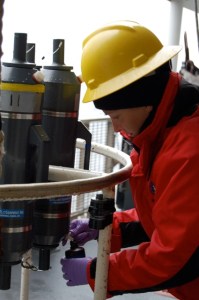NOAA Teacher at Sea: Natalie Macke
NOAA Ship: Oscar Dyson
Geographical area of cruise: Bering Sea

It seems my background in chemical oceanography is coming into some use this cruise. Since one of the scientists was not able to make the journey, the oceanography lab was short-handed. So, I immediately was put to work to help collect and process the oceanography samples. Below is a bit more about what that entails.
Scientists use an instrument referred to simply as a CTD (acronym for conductivity, temperature and depth) to electronically collect much of the physical ocean data. Shown to the right, the CTD is a rosette with numerous electronic sensors and water collection bottles (known as Niskin bottles) that is slowly lowered into the ocean. A cable electronically transmits data from the apparatus back up in real-time to the computer screen monitored by the scientists. Viewing the data, an immediate decision can be made as to where (at what depth) a water sample should be retrieved for further analysis.
Jeanette, the oceanographer on board, is viewing the screen with her log book. She’ll look at the pycnocline and fluorescence data to decide where she’ll “fire the Niskin bottles”. This simply means to send an electronic signal down to trigger the closing of the tube and thus capturing a water sample at that specific depth. The general plan is to capture samples from 5m above the seafloor, two samples on the bottom and then top of the pycnocline. Two additional samples will be also taken at the fluorescence maximum as well as near the surface.
The fluorescence maximum is where the fluorometer has identified the greatest biomass of phytoplankton in the water column.

Once the CTD has been recovered back onboard, we take samples from the Niskin bottles for further study… So what will we do with our samples??
– Sample for nutrients such as nitrates and nitrites (food for the phytoplankton)
– Sample for Oxygen-18 isotopes
– Sample for different sizes of phytoplankton by filtering various aliquots using filter paper with different pore sizes.


Once the samples are recovered from the Niskin bottles, (Each sample is given number associated with the depth from which it was collected) the samples are taken back to the oceanography lab for processing. Samples are filtered for a given size of phytoplankton. These sizes range from greater than 10 micrometers all the way down to GFF (greater than fine fraction) meaning anything smaller will be bacteria and viruses. The filter papers are recovered from the processing and will be brought back to shore for plankton analysis. Ultimately, this data will help confirm the analysis completed electronically by the fluorometer on the CTD. Our lab on the Oscar Dyson is quite nice and as long as seas remain calm as they have been, I have to say that my new job is one that I feel quite comfortable with…

| Oceanography Wet Lab |
I have to say that I have gotten accustomed to the layout of the Oscar Dyson quite quickly and easily. The levels are numbered with the Bridge being Level #1. My berth is on Level #4 and the Oceanography Lab and the Mess hall are both on Level #3. That’s pretty much all that I really have to know.. Since seas have been calm, the gentle rocking has simply acted as a sedative to make you want to eat Oreo cookies and then take a nap. I think I better locate the two gyms on board in the near future.. I have very much enjoyed getting to know the crew and scientists on board and look forward to learning much more from all of them. Even drills are a bit different on the Dyson…




